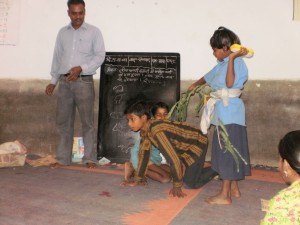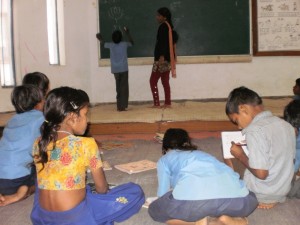Pre-School, Play, A Plate of Food: Transforming Tribal Kids In 60 Days
Life in the tribal belt of Rajasthan’s Udaipur district is very rough. Shrinking forests and pasture lands, on the one hand, and small, unproductive farm holdings, on the other, are
Life in the tribal belt of Rajasthan’s Udaipur district is very rough. Shrinking forests and pasture lands, on the one hand, and small, unproductive farm holdings, on the other, are squeezing life out of many a home, with the adult occupants forced to bundle up their few belongings and migrate in search of a livelihood. The grain – maize or wheat, sometimes both – tribal families scratch out from their rain-fed plots typically last for five months in the year. For the rest of the time, the community is dependent on small income from minor forest produce and through rearing goats. But with the forests under stress, this support base, too, is getting eroded. It’s the children, badly off in the best of times, who are paying the highest price for the disruption and destitution.
Imagine the life of a seven-year-old tribal Bhil or Garasiya child in Jhadol or Kotra block with some help from Narendra Pal Dhamor, a teacher from Kherwara and a long time observer of people living in the undulating stretches of rural Udaipur, “Technically, families here may not be landless, but the couple of bighas (one bigha is about 0.4 hectares) they own is insufficient to keep body and soul together. So people migrate and children often get left behind to the indifferent care of some member of the larger family or older siblings. They should be in school, but have either not been enrolled or have dropped out. As for food, they may be given a maize roti or two in the morning and then left largely to their own devices. So they roam around, graze cattle, play in the dust, fall sick, and over time grow into malnourished adults. Such is the cycle of existence in these parts.”

It is against this backdrop that the Dr Mohan Sinha Mehta Training Centre, run by the Udaipur-based organisation Seva Mandir, in Kaya village, has been working to suggest another future for these young lives. Situated on an 80-bigha campus some 25 kilometres from the picturesque lake city, the centre has for over a decade run three annual residential camps of around 60 days each – from January to March; May to June, and November to December – for about 180 to 200 children at a time, most of who come from impoverished tribal backgrounds.
Explains Angela Jacob of Seva Mandir, who supervises the Kaya programme, “A majority of kids here have either not attended school or have dropped out. Once a child completes three camps of 60 days at the Kaya centre, she or he will be able to do some basic reading, writing and counting in Hindi. We then try and place them in regular school.”
The first thing that strikes you about the Kaya centre is its airy, sun-lit classrooms alive with the voices of children. They double up as dormitories at night, as indicated by the neatly folded mattresses and blankets piled up in one corner. The children, mostly in the 6-14 year age group, have been divided into three categories: Kids with no experience of education are placed in the ‘C’ category; those with a basic understanding of letters and numbers make up the ‘B’ category, while those with higher skills comprise category ‘A’ – or graduate to that level during their days at the camp.
Within a month of camp life, most of them will be able to read from their worksheets and write on the blackboard with felicity. Not vowels or consonants but words signifying familiar objects – “matka” (pot), “nal” (tap), “aam” (mango), or the ubiquitous “billi” (cat) – are the basic building blocks of their learning. A lot of information is conveyed through stories and play acting, all of which is closely supervised by trained teachers adept at using learning material like flashcards conceptualised by educational organisations like the Madhya Pradesh-based Eklavya or developed at the Kaya centre itself.

A close relationship between the teacher and the taught – at a ratio of roughly one teacher for ten students – is what makes the teaching pay dividends. Says Manju Parmar, a teacher, “We don’t beat kids. We try and explain things, even if it takes more time. The children don’t live in fear and, unlike in a government school with its standard format that is followed blindly, we try to make learning fun. For instance, counting is taught using local material like stones or sticks.” Between 5 to 6 pm, games are played in the courtyard; there could also be cultural activities like music and dance. Dinner is served around 8 and it’s ‘lights out’ by 9.30 pm.
But learning, while important, is only half the story. What is striking about this intervention is its emphasis on nutritious meals and sanitation. It is this two-pronged approach of healthy eating and effective learning that brings about a metamorphosis in the kids.
When they arrive many children bear the marks of malnutrition, even starvation – bloated bellies, dry, reddish hair, stunted growth. They don’t know how to use a toilet or even wash their hands properly. Says Dalpath Singh Parmar, a supervisor at the Kaya centre: “It’s sad, but when they first come in they find it difficult to digest even our simple fare. Since most of them have almost been starving, regular food initially upsets their system and it takes a while for the normal appetite of childhood to assert itself. Once that happens, the kids look forward to the meals, after washing their hands and waiting patiently for their turn to be served.”
Breakfast could be ‘poha’ (a dish of beaten rice), sprouted ‘moong’ (lentil) or ‘dalia’ – a porridge made of semolina, either sweetened or salted. Lunch consists of freshly made ‘dal’, vegetables, rice and ‘rotis’. A similar fare is served for dinner. Fruit is often made available depending on the season. The children love bananas and mangoes. Every summer, the fruit-laden old mango trees in the Kaya centre campus never fails to thrill them.
While most of the food served is traditional Rajasthani fare, an interesting innovation is a soya unit run at the campus, which provides the children with soya milk once in two days. Laxman Singh, who operates it, is also adept at making tofu by splitting the milk and passing it through a cloth sieve. But protein rich tofu is not a favourite – and needs to be disguised by being mixed with dal or vegetables. Angela Jacob smiles, “In fact, these children, like children everywhere, resist food they are not familiar with, like ‘rajma’ or ‘chole’ (legumes). ‘Palak’ (spinach) too is disliked. What they do enjoy is the special Sunday meal when the favourite Rajasthani dish, ‘dal baati’, makes an appearance, or mithi lapsi – a sweet porridge made out of broken wheat.”

The Kaya centre demonstrates how children, who fall between the cracks of a ruthless rural order, can be given back their childhood. Educational camps cannot, of course, replace a proper school, but as M.S. Agwani, former vice-chancellor, Jawaharlal Nehru University, now based in Udaipur, observes, “An intervention like this can prove valuable when government schools don’t run well or when parents don’t see any value in sending children to them.”
Ravinder Kaur, Professor, Department of Humanities and Social Sciences, IIT Delhi, who has personally visited the centre puts it this way, “For children who exist outside the school system, a few months of regular care, in the company of other children like themselves, do amazing things. What struck me when I was there was the enthusiasm they displayed, their sheer peppiness. Their imagination had been given free play, they were encouraged to express themselves. They also have the energy to participate in all activities because they got good food. That, after all, is the central concern, isn’t it?”
This story made me
- 97
- 121
- 89
- 167











